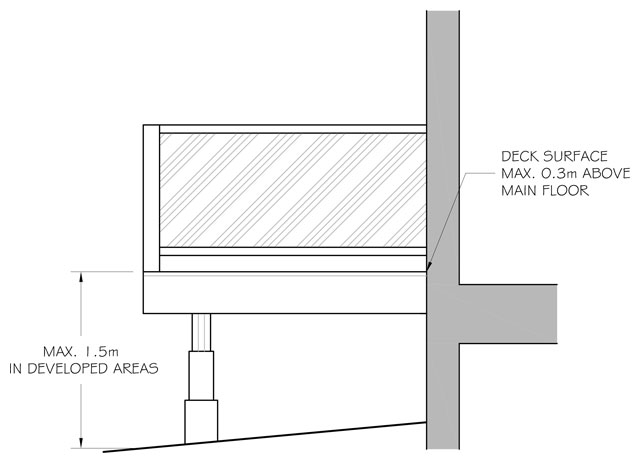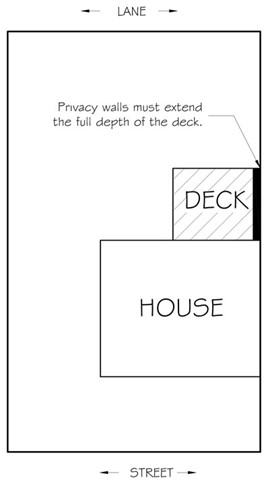Decks - Permits and application requirements
-
Do you need a permit?
Step 1 -
Submit your application
Step 3 -
Book your inspection
Step 5 -
Frequently asked questions
Extra information
Do you need a permit?
Use this interactive tool to find out which permits you need and get a fee estimate before you apply.
A Building Permit is required when:
- You are building a covered deck (i.e. a deck with a pergola or roof)
- You are building an uncovered deck whose surface is higher than 0.6m (2ft) above grade at any point.
- You are rebuilding, extending or adding stairs to an existing uncovered deck that is higher than 0.6m (2ft) above grade at any point.
A Building Permit is not required when:
You are building an uncovered deck that is 0.6m (2ft) or lower above grade at every point.
A Development Permit is required when:
- The property is within the floodway or within 6 metres of a floodway
- The deck is :
- located at the front of the home
- closer than 1.2m to a side property line
- closer than 6m to a rear property line
A Trade Permit is required if:
- Electrical or plumbing are part of your deck project.
Prepare your application
Begin with the Uncovered Deck Required Documents Checklist. It lists all required drawings and documents, along with helpful links to guide you through your application.
If you have questions or need clarification on the Land Use Bylaw rules, or have general permit questions, please contact the Planning Services Centre.
If you have questions or need clarification on the Building Code rules, contact the Technical Assistance Centre (Select Building Code inquiry).
Permit fees
| Item | Fee |
|---|---|
| Building Permit (new deck or changes to existing) | $205.92 |
| Development Permit (if required) | $550.00 |
Double-check the checklist before you submit!
If documents are missing or incomplete, your application cannot be reviewed.
Submit your application
Apply online
To apply online, you need a myID account. Create a myID account.
Apply in-person
Complete the application form.
Once you have gathered all required documents, you can apply for your permit in person by visiting the Planning Services Centre.
How do you pay for a permit?
Online submissions: For online submissions you will pay your permit fees in full at the time of your application using a credit card
In person submissions: You will be required to pay in full at the time of your application. You may pay by credit or debit card, cheque or cash.application.
Track your application
How to check the status of your permit
After you submit your application online, you will get a confirmation email with a Job Access Code (JAC).
To track your application and check its status, enter your Job Access Code in Vista.
If you need help or have questions, contact our Planning Services Centre.

The Planning Services Centre may contact you for more information required for your application. Follow-up on requests for more information as quickly as possible.
Use the Job Access Code (JAC) to check status updates for your application on calgary.ca/vista
Make changes to your application:
How long does it take to get a permit?
Permit approval timelines indicated are not a guarantee and depend on volumes, application completeness, and the applicant’s timely replies to additional information requests from the City.
Building permit: Deck applications are reviewed for bylaw and safety code compliance, and the review takes about 7 days.
Development permit (if needed for your deck): If the deck doesn’t meet all rules of the Land Use Bylaw, the decision takes about 60 days, followed by a 21-day advertisement/appeal period, for a total of 10–12 weeks.
City staff may reach out to you to request additional information.
An application for a permit may be refused if, within ninety (90) days from the date of receipt, if adequate information and documentation is not supplied as requested by the Safety Codes Officer. Should a permit be considered for refusal, the applicant will be given notification in writing and 30 days to resubmit the missing information. For more information, please review Building advisory A19-002 building permit complete application.
Book your inspection
City inspections ensure your deck meets minimum safety code standards.
Call for an inspection after you complete the deck structure, hand-rail and stairs. Ensure there is access to the structural components under the deck such as beams, posts, and joists.
The inspector will issue either a pass or fail result, and the deck is not considered complete until it passes.
Homeowners
Click before you dig
Always contact Utility Safety Partners before you dig. Submit a locate request online or call 1-800-242-3447 for more information.
Frequently asked questions
When does my permit expire?
You will receive a permit expiry reminder in the mail. If you need more time, you can extend your permit. Review the extend or reinstate your permit section.
| Permit type | Expiry (from date of issuance) |
|---|---|
| Building permit | 180 days |
| Development permit |
Your permit conditions will outline your commencement date. Commencement date is the day you must start construction by for the Development permit to be valid. If you do not start construction by that date, you can request an extension of commencement. |
Do I need to hire a professional?
If you are hiring someone to do the work for you, they will need to apply for the permit. Visit our hiring a contractor page to review the 5 steps to choosing a contractor.
Refer to the required documents checklist to see if you require engeineer's review. If your project requires it, then a seal of professional engineer registered to practice in the province of Alberta for the proposed design should be provided. The engineer should be registered with APEGA- The Association of Professional Engineers and Geoscientists of Alberta. Please visit APEGA website for professional engineer’s stamp authentication requirements.
The property has a zero-lot line, where can I build?
- Zero lot lines allow you to build your deck to your side property line.
- Zero lot lines commonly exist in combination with maintenance access rights-of-way on the opposite side of the property and on neighbouring properties.
- Review your maintenance access right of way (MARW) document attached to your property’s certificate of title for specific regulations
- If you are building into a maintenance access right-of-way, you must provide a copy of the document at the time of application.
How high is my deck allowed to be?
If your property is in the developed area:
- the maximum height for a deck that is not located on the same facade as a basement walkout entry is 1.5 m
- a deck located above the same facade as a walkout entry can exceed 1.5 m,
- but if must not exceed 0.3 m above the main floor level of a house.
If your property is in the developing area:
- There is no maximum height for a deck provided that:
- it does not exceed 0.3 m above the main floor level of a house.

Do I need a privacy wall around my deck?
Do you need a privacy wall?
If your deck or balcony is within 1.2m of a shared property line for a semi-detached, rowhouse or townhouse building, then you will need a privacy wall that is:
- at least 2.0 m high and not more than 3.0m high, measured from the surface of the deck
- must extend the full depth of the deck (parallel to the property line)
In all other instances, a privacy wall is not necessary, however if you want to install a privacy wall on a deck or balcony for a single detached dwelling:
- the maximum height is 2.0 m.
What are the design rules for balconies?
- Rules vary for balconies based on whether they are open or recessed.
- Open balconies must not project more than 1.85 m from the building façade to which it is attached.
- A recessed balcony must not exceed 10 m² in floor area.
- All balconies:
- Must not project into any side or front setback area.
- May project a maximum of 1.5 m into any rear setback area. In most cases it must be at least 6.0 m from the rear property line.
- May be a maximum length of 3.1 m when located in a rear setback area
If you are building a balcony, you are creating an addition to the home. See the additions page for requirements.
What is the minimum railing height for my deck?
If the surface of your deck is less than 1.8m (5’-11”) above the adjacent ground level:
- A 0.9m (3’-0”) high railing is required
If the surface of your deck is 1.8m (5’-11”) or more above the adjacent ground level:
- A 1.07m (3’-6”) high railing is required.
Refer to Division B, 9.8.8.3. of the 2019 National Building Code – Alberta Edition for more information.
What is the spacing requirement between railing balusters?
The maximum rail opening is 100mm (0'-4") wide.
Refer to Division B, 9.8.8.5. of the 2019 National Building Code – Alberta Edition for more information.
Planning Services Centre
Hours:
Monday - Friday
8 a.m. - 4 p.m. (MT)
Live chat:
calgary.ca/livechat
Call:
403-268-5311
In person:
Planning Services Centre,
3rd floor, Municipal building
800 Macleod Trail SE
Book an eAppointment for in person services at appointment.calgary.ca
Please note: The Property Research Counter will be temporarily closed from
8:00 - 9 a.m. (MT) on the first Tuesday of each month.


